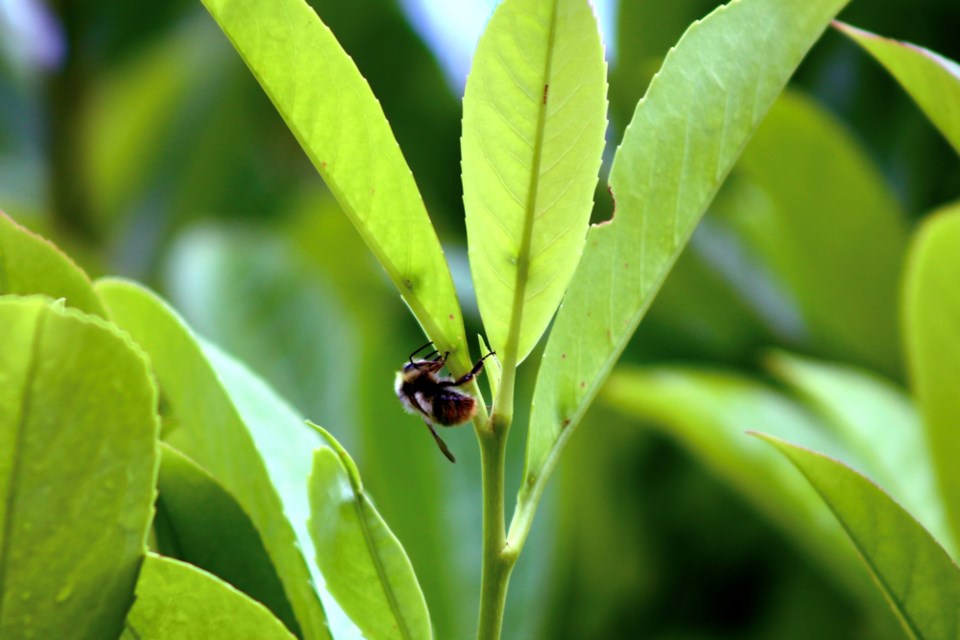The greatest gift and the heaviest burden that I received during my permaculture education and regenerative journey forever changed the way in which I experience my life and everything in it.
I can now see problems as opportunities, and ironically, experience more peace, happiness and relationship than I ever thought possible.
Perception is everything, and therein lies the solution. By shifting our beliefs about what is beautiful and what is not, what needs doing and what does not, and what is important and what is not, we can build the life that we want without causing environmental harm.
Prunus laurocerasus for example. English laurel, a.k.a. cherry laurel, is considered an invasive species on the North Shore. Indeed it can be, but then so are we, so in fairness we should try to get along. As a regenerative practitioner, I would absolutely not plant a new English laurel hedge today. I would instead plant a diverse native hedgerow around a sturdy and productive perennial shrub like evergreen huckleberry. We are where we are, however, so we can meet nature where she is, adapt, and adjust our thinking.
The 75 year-old English laurel hedge that runs the perimeter of our property was once a pain in the butt to me. I resented its crazy insatiable growth habit, the endless brown dead leaf litter that messed up the driveway, and the costly quarterly haircuts.
Today, through fresh eyes, we see the hedge as critical native habitat and food for birds, small mammals, ground-nesting bees, insects, and the trillions of microorganisms that thrive in the soil below. We are happy to let be the non-conforming masses of unwieldy branches of new growth that appear seemingly overnight, until the wild things that depend on them for sustenance have had their fill.
We celebrate (most days) the mess of leaf litter, heartened that tiny bird parents let it loose during nest building and while darting in and out to feed their babies.
We revel in the buzz – in the beautiful thrum of bees and other pollinators feasting gratefully on sugary laurel leaf nectar, satisfied in knowing that the thick hedges, made dense and impenetrable through years of disciplined barbering, provide both protection from predator birds and mammals, and an incubator for growing food for them.
We rest easy about the mess, knowing that tiny feet of ground-hopping birds, like towhees and sparrows, render the massive dried leaves into mulch, and deposit their droppings to help it all break down into fodder for shredder insects, worms, fungi, and other decomposers – creating, ultimately, rich living soil to draw carbon out of the atmosphere.
In our home gardens, during May and June, before most perennial flowers have come in to bloom, thousands of bees feast on the sugary nectar produced by hundreds of thousands of extrafloral (outside of, not inside flowers) nectaries that appear at the base of the leaves in new English laurel growth.
The nectaries present initially as tiny dark shadows, punctuating the translucent lime green foliage. We were concerned at first about fungal disease, but learned quickly through observation that the black spots preceded nectar glands, evolving in unison, forming a massive buffet of nourishment for bees and other pollinators, at a time when food was less than abundant elsewhere in the gardens.
Interestingly, just as soon as the lavender berms that ring our boulevards come into bloom, the bees leave the laurel en-masse, leaving it to the ants and wasps, whose mutualistic job it seems is to feast generously while at the same time protecting the new growth from opportunistic predator insects and birds with a taste for tender greens. Nature is so clever.
Certainly we must trim our laurel hedges for sight-lines, for aesthetics, and in consideration of our neighbours, but we can do so with patience, allowing the wild things to first take what they need. We can rake dead leaves gently underneath, treat brittle elder hedges with TLC to protect their sheltering habit, and avoid idling vehicles alongside spewing toxic exhaust into slumbering bird and bee nurseries.
With fresh eyes and optimism, we can do these small things for our children and for the planet.
Laura Marie Neubert is a West Vancouver-based urban permaculture designer. Follow her on Instagram @upfrontandbeautiful, learn more about permaculture by visiting her Upfront & Beautiful website or email your questions to her here.
For a taste of permaculture, click on the YouTube link below:
(Video - Courtesy of West Vancouver Memorial Library)



